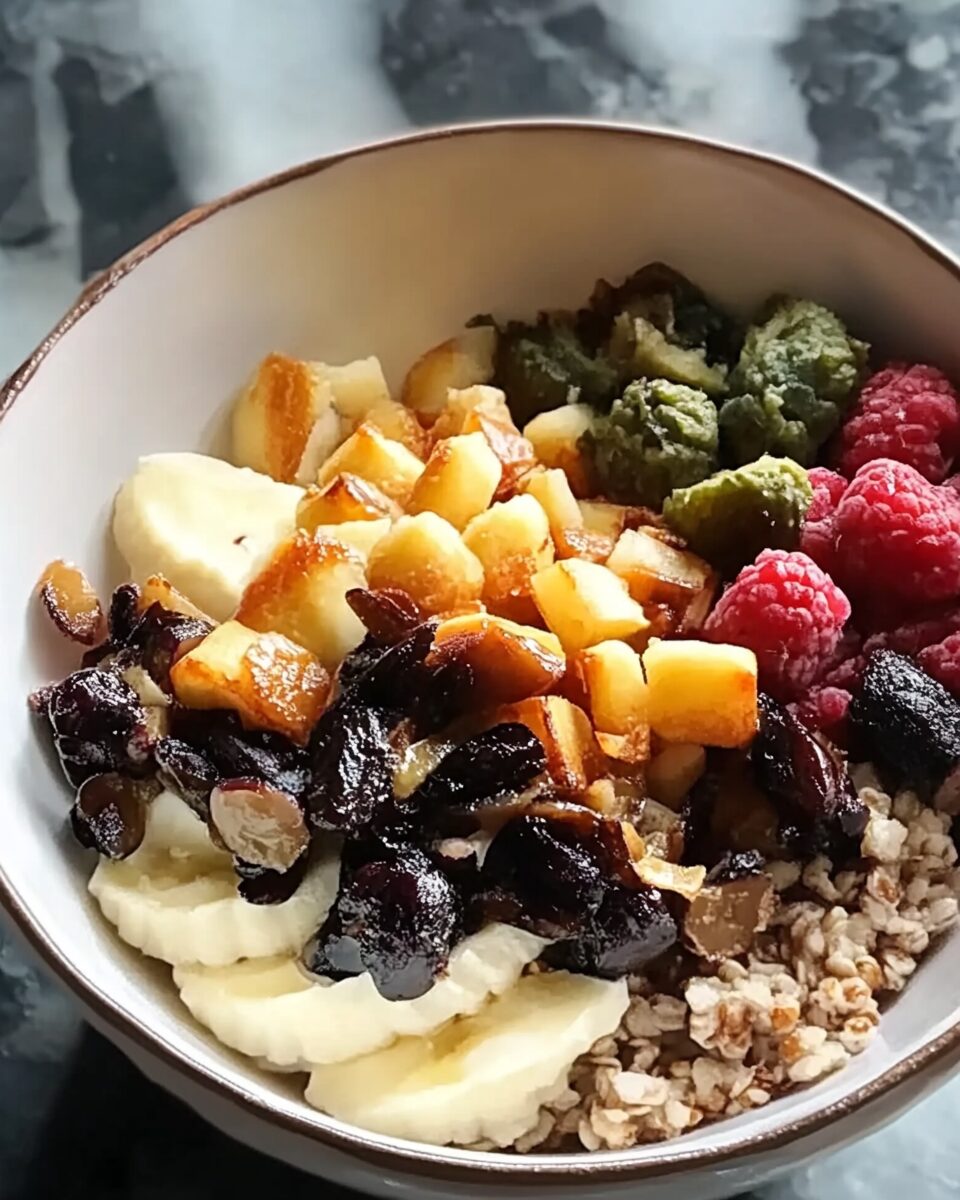The Sorghum Buddha Bowl is a hearty and nutritious meal that combines the ancient grain sorghum with a variety of roasted vegetables, black beans, and a tangy miso dressing. This plant-based dish offers a delightful blend of textures and flavors, making it a satisfying option for both lunch and dinner.
Full Recipe:
Ingredients:
- 2 cups water
- ½ cup whole grain sorghum
- 1 cup Brussels sprouts, trimmed and halved
- 1 cup cubed butternut squash
- 1 jalapeño, halved lengthwise and seeded
- 2 tablespoons sesame seeds
- 2 tablespoons olive oil, divided
- 1 head radicchio, cut into eighths
- 1 leek, trimmed and chopped
- Miso Dressing:
- 2 tablespoons sesame oil
- 1 tablespoon brown miso
- 1 tablespoon white rice vinegar
- 1 tablespoon toasted sesame oil
- 1 teaspoon grated fresh ginger
- 1 cup cooked black beans
Directions:
- Cook the sorghum: In a saucepan, bring 2 cups of water and ½ cup of whole grain sorghum to a boil. Reduce heat to medium-low, cover, and simmer until the sorghum is tender and the water is absorbed, approximately 45 to 50 minutes.
- Prepare the vegetables: Preheat the oven to 400°F (200°C) and line a baking sheet with parchment paper. In a bowl, combine 1 cup of halved Brussels sprouts, 1 cup of cubed butternut squash, 1 halved and seeded jalapeño, 2 tablespoons of sesame seeds, and 1 tablespoon of olive oil. Toss until evenly coated. Arrange the mixture on the prepared baking sheet.
- Roast the vegetables: Add 1 head of radicchio (cut into eighths) and 1 chopped leek to the baking sheet. Drizzle with the remaining 1 tablespoon of olive oil. Roast in the preheated oven until the radicchio and leek are wilted and browned (about 10 minutes). Remove the radicchio and leek, and continue roasting the squash mixture until tender and browned, an additional 5 to 10 minutes. Once done, slice the jalapeño into thin strips.
- Prepare the miso dressing: In a bowl, whisk together 2 tablespoons of sesame oil, 1 tablespoon of brown miso, 1 tablespoon of white rice vinegar, 1 tablespoon of toasted sesame oil, and 1 teaspoon of grated fresh ginger until smooth.
- Assemble the bowl: Divide the cooked sorghum into serving bowls. Top with the roasted vegetables and 1 cup of cooked black beans. Drizzle the miso dressing over each bowl before serving.
Nutritional Facts:
Per serving:
- Calories: 600
- Total Fat: 32g
- Saturated Fat: 5g
- Cholesterol: 0mg
- Sodium: 600mg
- Total Carbohydrate: 70g
- Dietary Fiber: 15g
- Sugars: 8g
- Protein: 15g
The Origins and Popularity of Buddha Bowls
Buddha bowls have become a staple in modern health-conscious diets, but their origins are somewhat unclear. The term “Buddha bowl” is believed to have been inspired by the concept of balance and mindfulness in Buddhism. Some sources suggest that the name comes from the idea of monks collecting a variety of vegetarian foods in their bowls during their daily alms rounds.
In recent years, Buddha bowls have become incredibly popular due to their flexibility and ability to incorporate a wide range of ingredients. They can be tailored to suit different dietary preferences, making them a go-to meal for vegans, vegetarians, and health enthusiasts. Unlike traditional grain bowls, which often focus on a single type of grain or protein, Buddha bowls emphasize diversity, offering a combination of textures, flavors, and nutrients in one dish.
Why Sorghum is a Great Choice for Buddha Bowls
Sorghum is an ancient grain that has been cultivated for thousands of years and is a dietary staple in many parts of Africa and Asia. It is naturally gluten-free and packed with essential nutrients, making it an excellent grain alternative for people with gluten sensitivities or those looking to diversify their diets.
Here are some key reasons why sorghum is an ideal base for a Buddha bowl:
- Rich in Fiber – Sorghum is high in dietary fiber, which aids digestion, promotes gut health, and helps regulate blood sugar levels.
- High in Protein – Unlike refined grains, sorghum contains a significant amount of protein, making it a great option for plant-based diets.
- Loaded with Antioxidants – This grain is packed with antioxidants that help fight inflammation and support overall health.
- Gluten-Free and Easy to Digest – Unlike wheat and barley, sorghum does not contain gluten, making it suitable for people with celiac disease or gluten intolerance.
- Sustainable and Drought-Resistant – Sorghum is an environmentally friendly grain that requires less water to grow, making it a more sustainable choice compared to other grains like rice or wheat.
The Nutritional Benefits of Roasted Vegetables in This Dish
Vegetables are a crucial part of a balanced Buddha bowl, adding vitamins, minerals, fiber, and antioxidants. In this Sorghum Buddha Bowl, roasted Brussels sprouts, butternut squash, radicchio, and leeks provide a variety of health benefits.
- Brussels Sprouts – These cruciferous vegetables are rich in vitamin K, vitamin C, and folate. They also contain powerful antioxidants that help reduce inflammation.
- Butternut Squash – A great source of vitamin A, potassium, and fiber, butternut squash adds a natural sweetness and creamy texture to the dish.
- Radicchio – Known for its slightly bitter taste, radicchio is packed with antioxidants and supports digestive health.
- Leeks – A member of the allium family, leeks provide prebiotics that support gut health and are a great source of vitamin A and K.
Roasting these vegetables enhances their natural flavors, caramelizes their sugars, and adds a delicious depth to the Buddha bowl. The combination of sweet, bitter, and umami flavors creates a well-balanced dish that is both nourishing and satisfying.
The Role of Black Beans in This Dish
Black beans are an excellent source of plant-based protein and fiber, making them a valuable addition to this Buddha bowl. They offer numerous health benefits, including:
- High Protein Content – Black beans provide a substantial amount of protein, making them a great meat alternative in vegetarian dishes.
- Rich in Fiber – The high fiber content helps support digestion, lowers cholesterol levels, and keeps you full for longer.
- Packed with Antioxidants – Black beans contain anthocyanins, which have anti-inflammatory and disease-fighting properties.
- Supports Heart Health – Their combination of fiber, potassium, and magnesium helps maintain heart health and regulate blood pressure.
The Flavorful Impact of Miso Dressing
One of the highlights of this dish is the miso-ginger dressing, which ties all the ingredients together with its bold umami flavor. Miso is a fermented soybean paste commonly used in Japanese cuisine. It adds depth and complexity to dishes while offering a range of health benefits.
- Rich in Probiotics – Because miso is fermented, it contains beneficial probiotics that support gut health.
- Enhances Digestion – The fermentation process makes miso easier to digest while also improving nutrient absorption.
- Packed with Essential Nutrients – Miso is a good source of B vitamins, iron, and zinc, all of which are essential for overall health.
- Adds Umami Flavor – Miso provides a deep, savory taste that enhances the natural flavors of vegetables and grains.
The combination of miso, sesame oil, rice vinegar, and ginger creates a dressing that is both tangy and savory, bringing the Buddha bowl together in a harmonious way.
Variations and Customization Options
The beauty of a Buddha bowl is its versatility. You can easily modify this recipe based on your preferences, dietary needs, or ingredient availability. Here are some ways to customize your Sorghum Buddha Bowl:
- Add More Protein – For an extra protein boost, add grilled tofu, tempeh, or chickpeas.
- Use Different Vegetables – Swap out the Brussels sprouts and squash for roasted sweet potatoes, carrots, or kale.
- Try Different Dressings – Instead of miso dressing, experiment with tahini sauce, lemon-garlic vinaigrette, or a spicy peanut dressing.
- Make It Spicier – Add sliced jalapeños, red pepper flakes, or a drizzle of sriracha for extra heat.
- Incorporate Nuts and Seeds – Sprinkle pumpkin seeds, almonds, or cashews for added crunch and healthy fats.
Storage and Meal Prep Tips
This Buddha bowl is perfect for meal prep and can be stored for future meals. Here are some tips for storing and reheating:
- Refrigeration – Store the components separately in airtight containers in the refrigerator for up to 4 days.
- Freezing – Cooked sorghum can be frozen for up to 3 months. Store it in portioned containers for easy use.
- Reheating – Reheat roasted vegetables and sorghum in a skillet or microwave before assembling the bowl. The miso dressing can be stored in the fridge and drizzled over the bowl before serving.
Conclusion
The Sorghum Buddha Bowl is a nourishing and delicious meal that offers a perfect balance of grains, protein, and vegetables. It is packed with fiber, antioxidants, and essential nutrients, making it an excellent choice for a healthy and satisfying meal. Whether you’re looking for a plant-based lunch, a meal-prep-friendly option, or a new way to enjoy ancient grains, this Buddha bowl is a fantastic choice.






